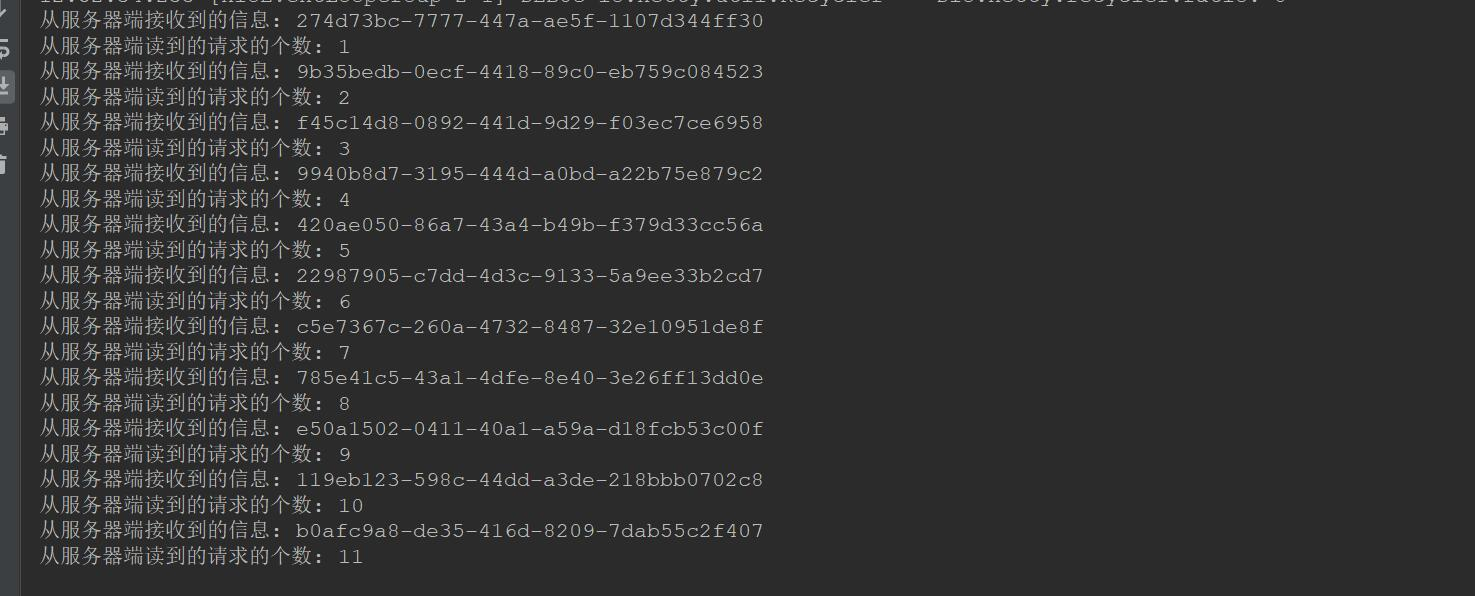What are sticking and unpacking?
The TCP protocol is a byte stream protocol with no record boundary. When we receive a message, the packet that cannot be received artificially is an entire package message.
When a client sends multiple message data to a server, the TCP protocol may combine multiple message data into a single packet for sending, which is called sticky packets.
When a client sends a message to a server that is too large, the tcp protocol may split a packet into multiple packets to send it, which is unpacking
The following example of netty shows examples of tcp sticking and unpacking:
ServerBusinessHanler:
import io.netty.buffer.ByteBuf; import io.netty.buffer.Unpooled; import io.netty.channel.ChannelHandlerContext; import io.netty.channel.SimpleChannelInboundHandler; import java.nio.charset.Charset; import java.util.UUID; public class ServerBusinessHanler extends SimpleChannelInboundHandler<ByteBuf> { int count = 0; @Override protected void channelRead0(ChannelHandlerContext ctx, ByteBuf msg) throws Exception { byte[] bytes = new byte[msg.readableBytes()]; msg.readBytes(bytes); String message = new String(bytes, Charset.forName("UTF-8")); System.out.println("String received from client:" + message); System.out.println("Number of requests received by the server:" + (++count)); ctx.writeAndFlush(Unpooled.copiedBuffer(UUID.randomUUID().toString(),Charset.forName("UTF-8")) ); } @Override public void exceptionCaught(ChannelHandlerContext ctx, Throwable cause) throws Exception { System.out.println(cause.getStackTrace()); ctx.channel().close(); } }
Server:
import io.netty.bootstrap.ServerBootstrap; import io.netty.channel.ChannelInitializer; import io.netty.channel.EventLoopGroup; import io.netty.channel.nio.NioEventLoopGroup; import io.netty.channel.socket.SocketChannel; import io.netty.channel.socket.nio.NioServerSocketChannel; import java.net.InetSocketAddress; public class Server { public static void main(String[] args) throws InterruptedException { EventLoopGroup bossGroup = new NioEventLoopGroup(1); EventLoopGroup workerGroup = new NioEventLoopGroup(); try { ServerBootstrap serverBootstrap = new ServerBootstrap(); serverBootstrap.group(bossGroup, workerGroup) .channel(NioServerSocketChannel.class) .childHandler(new ChannelInitializer<SocketChannel>() { @Override protected void initChannel(SocketChannel ch) throws Exception { ch.pipeline().addLast(new ServerBusinessHanler()); } }); serverBootstrap.bind(new InetSocketAddress(8899)).sync().channel().closeFuture().sync(); } finally { bossGroup.shutdownGracefully(); workerGroup.shutdownGracefully(); } } }
ClientBusinessHandler:
import io.netty.buffer.ByteBuf; import io.netty.buffer.Unpooled; import io.netty.channel.ChannelHandlerContext; import io.netty.channel.SimpleChannelInboundHandler; import java.nio.charset.Charset; public class ClientBusinessHandler extends SimpleChannelInboundHandler<ByteBuf> { int count = 1; @Override protected void channelRead0(ChannelHandlerContext ctx, ByteBuf msg) throws Exception { byte[] bytes = new byte[msg.readableBytes()]; msg.readBytes(bytes); System.out.println("Information received from the server side: " + new String(bytes, Charset.forName("UTF-8"))); System.out.println("Number of requests read from the server: " + count++); } @Override public void channelActive(ChannelHandlerContext ctx) throws Exception { for (int i = 0; i < 10; i++) { ctx.writeAndFlush(Unpooled.copiedBuffer("China Mobile".getBytes())); } ctx.writeAndFlush(Unpooled.copiedBuffer("jiaoyipingjiaoyipingjiaoyipingjiaoyipingjiaoyipingjiaoyipingjiaoyipingjiaoyipingjiaoyipingjiaoyipingjiaoyipingjiaoyipingjiaoyipingjiaoyipingjiaoyipingjiaoyipingjiaoyipingjiaoyipingjiaoyipingjiaoyipingjiaoyipingjiaoyipingjiaoyipingjiaoyipingjiaoyipingjiaoyipingjiaoyipingjiaoyipingjiaoyipingjiaoyipingjiaoyipingjiaoyipingjiaoyipingjiaoyipingjiaoyipingjiaoyipingjiaoyipingjiaoyipingjiaoyipingjiaoyipingjiaoyipingjiaoyipingjiaoyipingjiaoyipingjiaoyipingjiaoyipingjiaoyipingjiaoyipingjiaoyipingjiaoyipingjiaoyipingjiaoyipingjiaoyipingjiaoyipingjiaoyipingjiaoyipingjiaoyipingjiaoyipingjiaoyipingjiaoyipingjiaoyipingjiaoyipingjiaoyipingjiaoyipingjiaoyipingjiaoyipingjiaoyipingjiaoyipingjiaoyipingjiaoyipingjiaoyipingjiaoyipingjiaoyipingjiaoyipingjiaoyipingjiaoyipingjiaoyipingjiaoyipingjiaoyipingjiaoyipingjiaoyipingjiaoyipingjiaoyipingjiaoyipingjiaoyipingjiaoyipingjiaoyipingjiaoyipingjiaoyipingjiaoyipingjiaoyipingjiaoyipingjiaoyipingjiaoyipingjiaoyipingjiaoyipingjiaoyipingjiaoyipingjiaoyipingjiaoyipingjiaoyipingjiaoyipingjiaoyipingjiaoyipingjiaoyipingjiaoyipingjiaoyipingjiaoyipingjiaoyipingjiaoyipingjiaoyipingjiaoyipingjiaoyipingjiaoyipingjiaoyipingjiaoyipingjiaoyipingjiaoyipingjiaoyipingjiaoyipingjiaoyipingjiaoyipingjiaoyipingjiaoyipingjiaoyipingjiaoyipingjiaoyipingjiaoyipingjiaoyipingjiaoyipingjiaoyipingjiaoyipingjiaoyipingjiaoyipingjiaoyipingjiaoyipingjiaoyipingjiaoyipingjiaoyipingjiaoyipingjiaoyipingjiaoyipingjiaoyipingjiaoyipingjiaoyipingjiaoyipingjiaoyipingjiaoyipingjiaoyipingjiaoyipingjiaoyipingjiaoyipingjiaoyipingjiaoyipingjiaoyipingjiaoyipingjiaoyipingjiaoyipingjiaoyipingjiaoyipingjiaoyipingjiaoyipingjiaoyipingjiaoyiping".getBytes())); } }
Client:
import io.netty.bootstrap.Bootstrap; import io.netty.channel.Channel; import io.netty.channel.ChannelInitializer; import io.netty.channel.EventLoopGroup; import io.netty.channel.nio.NioEventLoopGroup; import io.netty.channel.socket.SocketChannel; import io.netty.channel.socket.nio.NioSocketChannel; public class Client { public static void main(String[] args) throws InterruptedException { EventLoopGroup eventExecutors = new NioEventLoopGroup(); Bootstrap bootstrap = new Bootstrap(); bootstrap.group(eventExecutors) .channel(NioSocketChannel.class) .handler(new ChannelInitializer<SocketChannel>() { @Override protected void initChannel(SocketChannel ch) throws Exception { ch.pipeline().addLast(new ClientBusinessHandler()); } }); Channel channel = bootstrap.connect("127.0.0.1", 8899).channel(); channel.closeFuture().sync(); } }
Running the server side and the client side separately, we see the output from the server side:
Correspondingly, the server only returned two returns to the client, not the 11 we expected
The first part of the ten "China Mobile" strings we passed in from the client and the first part of the long string we sent the second time are stuck, while the second part of the long string is split into the second package.
Both sticking and unpacking occur
How do we solve the problem of sticking and unpacking? One way is to use a specific separator in the string, and the other way is to attach the length of the packet to the front when sending the packet
netty provides us with a variety of decoders, such as fixed-length decoders and delimiter-based decoders. Here, we use LengthFieldBasedFrameDecoder to solve the problem of sticking and unpacking. For more information about this decoder, you can refer to the java doc documentation of this class, which is very detailed and concise.Simply put, we need to add some information about the length of the data field to the request (hereinafter referred to as length), and in the construction method of the LengthFieldBasedFrameDecoder, set up information about the number of bytes length takes and the number of bytes to skip (we can skip the length information if we only need to read the data content)In this way, every packet we send from the client can be parsed correctly
First, we add an encoder to lenght the data package attachment:
import io.netty.buffer.ByteBuf; import io.netty.channel.ChannelHandlerContext; import io.netty.handler.codec.MessageToByteEncoder; //This class of actions, plus a four-byte header (type int), indicates the packet length public class LengthEncoder extends MessageToByteEncoder<ByteBuf> { @Override protected void encode(ChannelHandlerContext ctx, ByteBuf msg, ByteBuf out) throws Exception { int length = msg.readableBytes(); byte[] bytes = new byte[length]; msg.readBytes(bytes); out.writeInt(length); out.writeBytes(bytes); } }
Then add our encoder and the corresponding LengthFieldBasedFrameDecoder to ChannelInitializer on both the server and client sides
Modified server-side code:
import io.netty.bootstrap.ServerBootstrap; import io.netty.channel.ChannelInitializer; import io.netty.channel.EventLoopGroup; import io.netty.channel.nio.NioEventLoopGroup; import io.netty.channel.socket.SocketChannel; import io.netty.channel.socket.nio.NioServerSocketChannel; import io.netty.handler.codec.LengthFieldBasedFrameDecoder; import java.net.InetSocketAddress; public class Server { public static void main(String[] args) throws InterruptedException { EventLoopGroup bossGroup = new NioEventLoopGroup(1); EventLoopGroup workerGroup = new NioEventLoopGroup(); try { ServerBootstrap serverBootstrap = new ServerBootstrap(); serverBootstrap.group(bossGroup, workerGroup) .channel(NioServerSocketChannel.class) .childHandler(new ChannelInitializer<SocketChannel>() { @Override protected void initChannel(SocketChannel ch) throws Exception { ch.pipeline().addLast(new LengthFieldBasedFrameDecoder(4096,0,4,0,4)); ch.pipeline().addLast(new LengthEncoder()); ch.pipeline().addLast(new ServerBusinessHanler()); } }); serverBootstrap.bind(new InetSocketAddress(8899)).sync().channel().closeFuture().sync(); } finally { bossGroup.shutdownGracefully(); workerGroup.shutdownGracefully(); } } }
new LengthFieldBasedFrameDecoder(4096,0,4,0,4)); means: The maximum packet size with LengthFieldBasedFrameDecoder is 4096, with length accounting for four bytes and reading skipping four bytes (that is, ignoring the length field and returning only the real data content when decoding is done)
Modified client code:
import io.netty.bootstrap.Bootstrap; import io.netty.channel.Channel; import io.netty.channel.ChannelInitializer; import io.netty.channel.EventLoopGroup; import io.netty.channel.nio.NioEventLoopGroup; import io.netty.channel.socket.SocketChannel; import io.netty.channel.socket.nio.NioSocketChannel; import io.netty.handler.codec.LengthFieldBasedFrameDecoder; public class Client { public static void main(String[] args) throws InterruptedException { EventLoopGroup eventExecutors = new NioEventLoopGroup(); Bootstrap bootstrap = new Bootstrap(); bootstrap.group(eventExecutors) .channel(NioSocketChannel.class) .handler(new ChannelInitializer<SocketChannel>() { @Override protected void initChannel(SocketChannel ch) throws Exception { ch.pipeline().addLast(new LengthFieldBasedFrameDecoder(4096,0,4,0,4)); ch.pipeline().addLast(new LengthEncoder()); ch.pipeline().addLast(new ClientBusinessHandler()); } }); Channel channel = bootstrap.connect("127.0.0.1", 8899).channel(); channel.closeFuture().sync(); } }
What we get after running the server side and the client side respectively:
Server-side output:

Client Output:
This solves the problem caused by sticking and unpacking